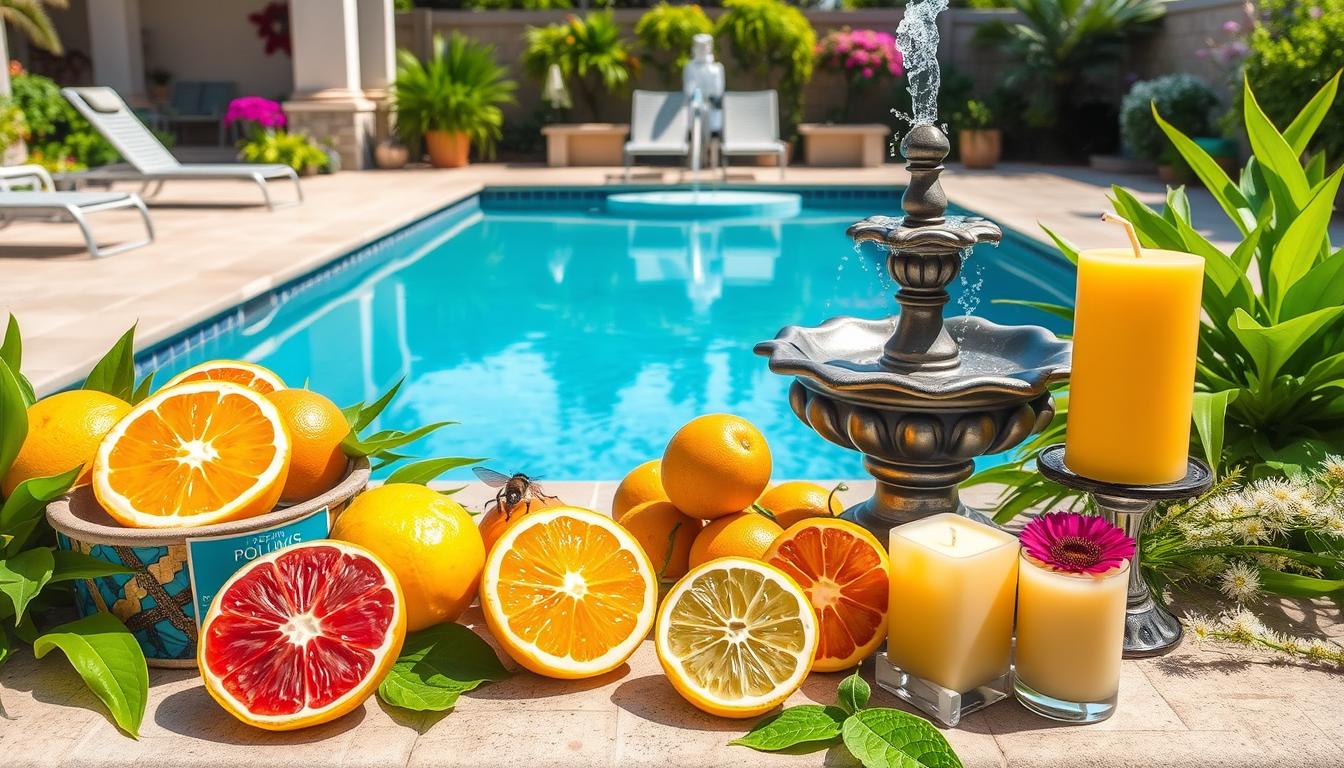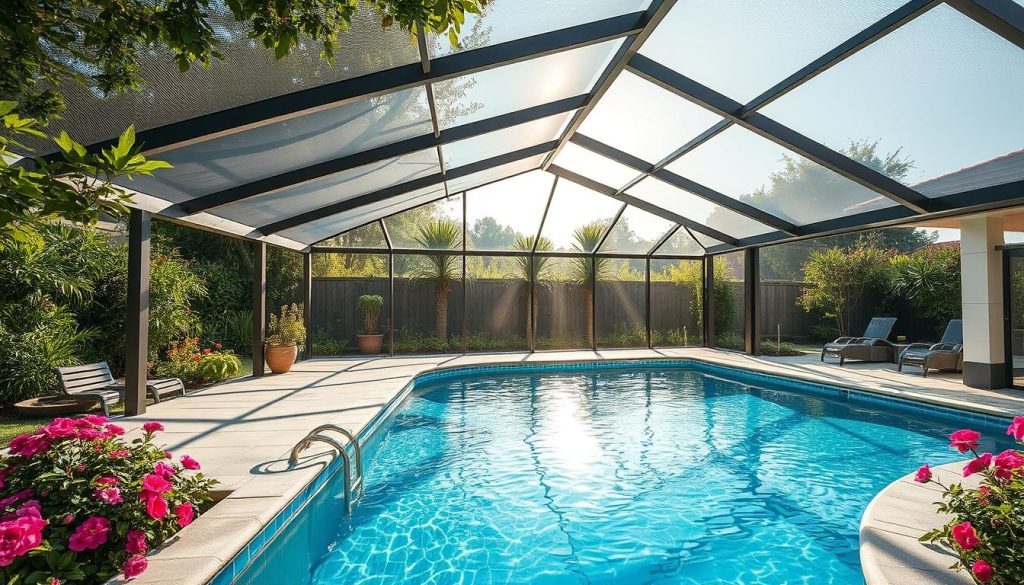
Summer heat draws us to our swimming pools. But we’re not alone. Honey bees also seek water there. They’re vital to our ecosystem, but risky around pools.
Swimmers, especially those with allergies, face dangers. We’ll explore ways to repel bees from pools. Our goal is to ensure safe, fun swimming for everyone.
Bee stings can range from mild to severe. It’s crucial to use bee deterrents for pools. Bees are attracted to chlorine and salt scents.
We’ll guide you on keeping honey bees away. You’ll learn natural deterrents and pool maintenance tips. These methods will help create a bee-free zone.
Key Takeaways
- Honey bees are attracted to pools for hydration during hot summer months
- Bee stings can cause discomfort and severe allergic reactions, making bee control crucial
- Effective bee deterrents include bee-repelling plants, scent-based deterrents, and alternative water sources
- Maintaining a clean pool environment and utilizing water jets can help prevent bee swarms
- Balancing bee safety and human comfort is essential when addressing bee problems around pools
Understanding the Importance of Bee Control Around Pools
Pool maintenance for bee control is crucial for a safe swimming environment. Honey bees are vital to our ecosystem. Yet, their presence near pools can risk swimmers’ safety.
Bee-proof pool enclosures and honey bee management can help. These strategies balance human comfort with respect for pollinators.

Risks Associated with Bee Stings
Bee stings can cause mild discomfort to severe allergic reactions. Sensitive individuals may experience swelling, redness, and itching at the sting site.
In rare cases, stings can trigger life-threatening reactions. These require immediate medical attention. Understanding these risks highlights the need for effective bee control.
| Reaction Type | Symptoms | Severity |
|---|---|---|
| Local Reaction | Swelling, redness, itching at sting site | Mild to moderate |
| Large Local Reaction | Swelling extending beyond sting site | Moderate to severe |
| Systemic Allergic Reaction (Anaphylaxis) | Difficulty breathing, hives, dizziness, nausea | Severe, potentially life-threatening |
Balancing Bee Safety and Human Comfort
Human safety around pools is vital. However, we must also consider honey bees’ role in our environment. Bees are crucial pollinators.
Bee control should balance pool safety with respect for nature. This can be achieved through pool maintenance, beekeeping safety, and bee-proof enclosures.
Understanding bee sting risks and maintaining harmony outdoors helps develop effective pool strategies. These methods avoid stings while protecting essential pollinators.
Effective honey bee management around pools includes:
- Regular pool maintenance to minimize attractants for bees
- Implementing bee-proof pool enclosures
- Promoting beekeeping safety practices in the surrounding area
- Educating pool users about bee behavior and sting prevention
A comprehensive approach to bee control creates a safer swimming environment. It also respects honey bees’ crucial role in our ecosystem.
Natural Ways to Deter Bees from Your Pool Area
Creating a safe pool environment is crucial for family and friends. Bees are vital to our ecosystem, but can be concerning near pools. Let’s explore natural methods to deter bees without harming them.
Using Bee-Repelling Plants
Planting bee-repelling plants around your pool is highly effective. Peppermint, spearmint, and citronella naturally deter bees with their strong scents. Bees dislike these smells and avoid areas where they grow.
The Xerces Society reports that peppermint plants can boost honey production. A single colony can produce up to 200 pounds of honey. This makes peppermint an excellent choice for pool areas.
Implementing Scent-Based Deterrents
Scent-based repellents offer another way to keep bees away from pools. Dryer sheets effectively repel bees and wasps due to their strong smell. Place a few sheets around your pool to create a scent barrier.
Cloves are another powerful deterrent. Spread them around the pool area to repel bees and wasps. Their pungent aroma is unappealing to these insects, keeping them at bay.
Maintaining a Clean and Tidy Pool Environment
A clean pool environment minimizes bee attractants. Regularly clean your pool and surrounding areas. Remove standing water and keep the area free of debris.
Cover food and drinks when dining near the pool. This prevents sweet scents from attracting bees. A tidy pool area significantly reduces the chance of bee encounters.
| Natural Bee Deterrent | Effectiveness |
|---|---|
| Peppermint and Spearmint Plants | High |
| Citronella Plants | Moderate |
| Dryer Sheets | High |
| Cloves | Moderate |
| Regular Pool Cleaning | High |
These natural methods effectively deter bees while respecting their ecosystem role. Our goal is to make the pool area less appealing to bees. This ensures a safe and enjoyable experience for everyone.
Additional Methods to Keep Honey Bees Away from Pool
Natural deterrents help reduce bee activity around pools. But there are more ways to discourage bees from gathering near your pool. Water jets, mothballs, and alternative water sources can redirect bees effectively.
Utilizing Water Jets and Mothballs
Water jets or fountains create movement, making it hard for bees to access the surface. This reduces their attraction to the pool area. Hanging mothballs in mesh bags around the pool can also repel bees.
Mothballs have a strong scent that bees dislike. While not visually appealing, they work well during peak bee season. Consider them a temporary solution for your pool area.
Providing Alternative Water Sources for Bees
Offer bees other water sources to keep them away from your pool. Set up birdbaths or shallow dishes with water and marbles away from the pool area. This attracts bees to these spots instead of your pool.
Place these alternative sources away from high-traffic areas in your yard. This creates a diversion for bees while keeping your family and guests comfortable and safe.
When creating bee-friendly water spots, consider the following tips:
- Use shallow dishes or birdbaths with a depth of no more than 2 inches to prevent bee drowning
- Add marbles, stones, or sticks to the water to provide landing spots for bees
- Place the alternative water sources in a shaded area to keep the water cool and fresh
- Regularly clean and refill the water to maintain hygiene and attract bees
| Method | Effectiveness | Ease of Implementation |
|---|---|---|
| Water Jets | High | Moderate (requires installation) |
| Mothballs | Moderate | Easy (hang in mesh bags) |
| Alternative Water Sources | High | Easy (set up birdbaths or dishes) |
Use these methods along with natural deterrents and regular pool cleaning. This will keep honey bees away from your pool area. Your outdoor space will become more enjoyable for everyone.
Conclusion
Effective bee control for pools combines natural deterrents and alternative water sources. This balance ensures pool users’ safety while respecting bees’ vital role. We can maintain a bee-free pool area with these methods.
Keep the pool area clean and tidy. Cover food and drinks when outdoors. Avoid strong fragrances to reduce the area’s appeal to bees. Seal gaps in homes to minimize bee activity around living spaces.
These strategies create a safer swimming experience for everyone. They also promote bee safety in our outdoor spaces. By implementing these methods, we foster harmony between humans and pollinators.







